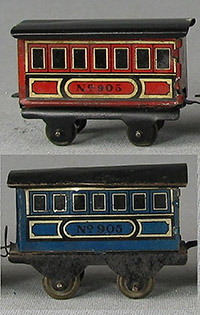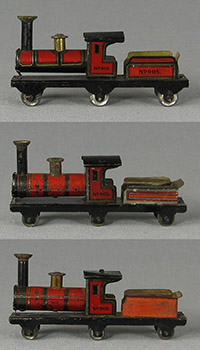 |
||||
|---|---|---|---|---|
| Hess 100 Series Transition, circa 1900 It is interesting to watch Hess products in the transition of manufacturing methods and styles. This boxed set contains a pre-litho locomotive, a tender with pasted paper litho, and one passenger car with lithography direct to tinplate – all milestones for Hess in the manufacturing development of their products. It is very unusual to see all three methods of production packed into one box. |
||||
| Hess or Issmayer for Carette? Three versions of the Hess series 100 locomotive. It has generally been thought that Hess was the maker of all 905 trains for Carette, however, upon close examination there appear to be some very minor differences. Top locomotive shown has different graphics, slightly longer frame, wider frame, different style wheel supports, larger diameter wheels, couplers in front and back, and different style axles. These locos appear almost identical, but would require new tooling which would not be economical for a single manufacturer. I conclude that this loco was manufactured by a different company than Hess and was probably Issmayer for Carette. Bottom two locos are by Hess and are almost identical with the exception of tender graphics. |
||||
 |
Hess or Issmayer for Carette? Two similar passenger cars in the Hess 100 style, marked “905” for Carette, but with subtle differences. Different graphics, wheel size, axles and axle supports. In addition, the blue car uses tab and slot construction to connect to the frame whereas the red car’s body is wrapped around a groove in the frame. Once again, as with the locomotive, the changes would require different tooling. I suspect this blue car was made by Issmayer, the red car by Hess. |
|||
 - Copy.jpg) |
Hess 100 Series Passenger / Mail / Freight Car Colors, Circa 1900 The early series 100 passenger cars were produced in yellow, blue, red and brown. The mail car was lithographed in green, and box car with vertical slats in gray. Bodies of the cars were crimped into horizontal grooves in the frame and only one corner of the body used 5 tabs without slots to fasten. Female couplers were more of a rectangular shape with half-moon holes. Primary identification for early cars is the white serif numerals “100” outlined in black. |
|||
 - Copy - Copy.jpg) |
Hess 100 Series Passenger / Mail / Freight Car Colors, Circa 1920s The later series 100 passenger cars were produced in yellow, blue, red and green. Graphics were modified to include three panels separated with diamond shaped graphics. The mail car was lithographed in maroon red, and boxcar with horizontal slats, in gray. These mid production trains did away with the grooved frames and used 4 tabs and slots in construction through the frame with the one body corner using 5 tabs without slots to fasten. Female couplers were more of a semi-circular shape with round holes. Primary identification for these cars is the black serif letters and numerals (“No. 100”). These cars had the words “Ges. Gesch” printed on one end. |
|||
| Hess 100 Series Passenger / Mail / Freight Car Colors, Circa late 1920s – 1934 The latest and last series 100 passenger cars were produced in yellow, blue, red and green. Graphics were slightly modified but still used three panels divided by diamond shaped graphics. Another construction change included 6 tabs and slots through the frame with the one body corner using 5 tabs without slots. Primary identification for these cars is the black sans-serif letters and numerals in “No. 100” printed on the sides. These cars had the words “Ges. Gesch” printed on one end. |
||||
.jpg) |
Hess early 100 series 2 axle locomotive marked “M H” (Matthias Hess) As Hess developed their new lithographic line of trains, this very early 2 axle locomotive shows some of the trial and error in developing the product. The two axle locomotive used thicker side rails to strengthen the frame, but apparently was not enough support as Hess went to three axles for this series until the end of production in 1934. The tender is painted but I am unsure whether paper litho was applied as with other early versions. The only other 2 axle locomotives produced in this series were shorter and without tender. The early 3 axle locomotive shown below closely followed in manufacture and is all litho printed.
|
|||

.jpg)

